|
DeDion Bouton
|
1883
- 1932 |
Country: |
 |
|
If you were ablt to time travel to Paris in the 1880s, you would find few names that were better known than that of Albert, Comte de Dion, scion of one of France's most distinguished noble families. He was, by all accounts, a fast liver - and a notorious duellist - with a passion for machinery which somewhat distressed his family.
But, added a contemporary: 'He was more often seen in society drawing-rooms and even gaming-rooms, than in workshops and laboratories'. It was, in fact, when he was strolling down the fashionable Boulevard des Italiens in Paris, late in 1881, in search of gifts for the ladies at a New Year's ball he was helping to organise, that De Dion made the discovery that was to lead to his becoming the keenest driving force and most powerful creator in the early history of motor industry and motor sport.
In the window of the novelty shop run by one Giroux was a tiny model steam engine fired by methylated spirits. De Dion knew enough about steam engines to have built one some years previously, but this model was obviously special, as he not only bought it, but questioned Giroux about its makers, with a view to building a similar model.
He was told that the engine was the work of Georges Bouton, who had a tiny workshop in the passage Leon, in the rue de la Chapelle, where he and his brother-in- law, Trepardoux, made mechanical toys for Giroux, and showcase models for the Ducretet precision engineering company.
De Dion hurried round to the passage Leon to find that the two men were working virtually at starvation level, with only a few pennies coming in each week; it took little persuasion-and and very little money-for them to go into business with De Dion who proposed building steam cars.
Obviously, to build cars, they needed a lot more space than the small premises in the passage Leon could offer; they found what they were looking for, a dilapidated house with a largish garden, in the rue Pergolese, on the corner of the avenue de Malakoff. There Trepardoux, who was an accomplished steam-engineer, devised a boiler with an integral fire-box; this was installed in a spidery four-wheeled chassis, in which the engine drove the front wheels by twin belts, and the rear wheels steered.
The car was running in 1883, and it was not long before a much-improved three-wheeled version, with conventional steering and rear-wheel drive, made its appearance. This formed the basis for a production steam tricycle, of which several examples were sold during the 1880s. Already, however, the tall, portly De Dion and the short, heavily moustached Bouton were swinging away from steam as a motive force and experimenting with petrol engines of advanced design, including a ten-cylinder rotary in 1889.
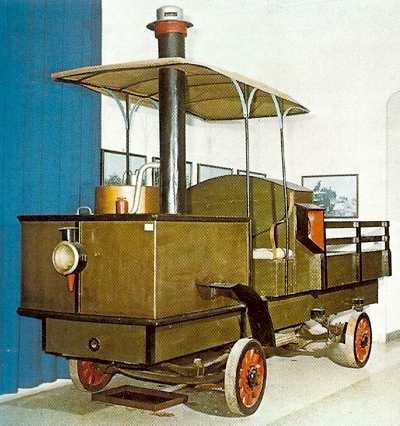 1889 DeDion steam wagon.
1889 DeDion steam wagon.
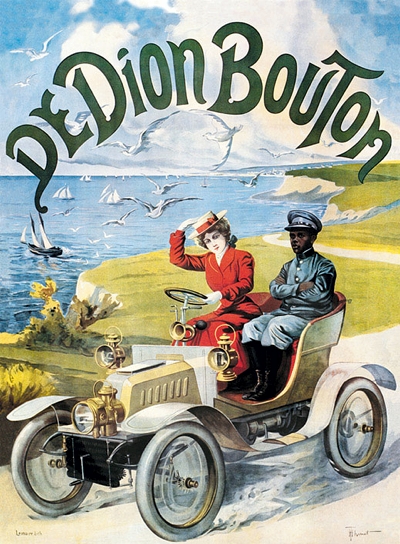 Advertising for a 1902 DeDion single cylinder runabout.
Advertising for a 1902 DeDion single cylinder runabout.
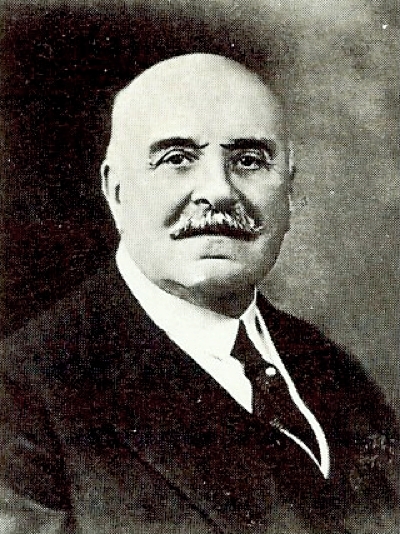 Albert de Dion.
Albert de Dion.
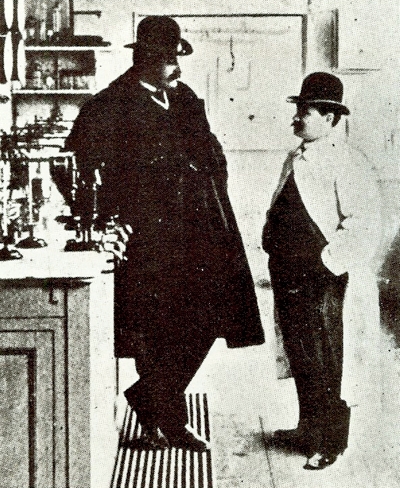 Albert de Dion (left) and Georges Bouton (right).
Albert de Dion (left) and Georges Bouton (right).
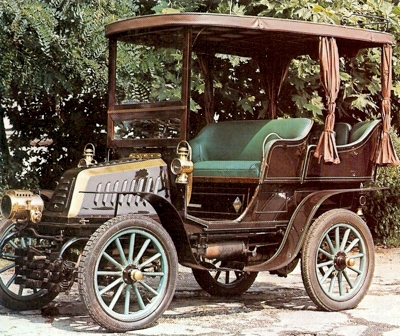 1902 DeDion Model K Single Cylinder.
1902 DeDion Model K Single Cylinder.
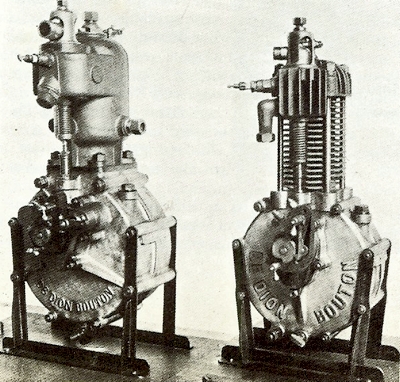 Two single cylinder De Dion engines.
Two single cylinder De Dion engines. |
Such activities were pure heresy to Trepardoux, who became more and more unhappy with the way the partnership was going. In 1894, this sullen defender of steam had had enough and resigned, though not before he had designed a steam break that featured an ingenious double rear axle, with the final drive mounted rigidly on the chassis, driving the rear wheels through universally jointed shafts. The weight of the car was carried on a dead tubular axle.
Unfortunately for M. Trepardoux, this arrangement (which was to be used on some cars for decades to come) kept the unsprung weight down, and become immortalised as the de Dion rear axle - and soon it would no bear no reference to him. With Trepardoux gone, the design of the steamers changed little over their remaining decade of production; indeed, it was difficult to see why De Dion kept them going for so long, as this side of the venture brought no profit.
In any case, Bouton had, in 1895, produced a new power unit whose fame would eclipse anything that his brother-in-law had ever done: it was a tiny 137 cc petrol engine, which seemed a failure at first, as its designed engine speed of 900 rpm made it run irregularly and knocked out its bearings.
However, when Bouton attempted to accelerate the engine further, he found that all the roughness disappeared completely, and reliability was vastly improved. On the test-bench, he could run his first engine at the then fantastic speed of 3500rpm, though in practice, 2000 rpm was a more realistic figure, taking account of the limitations of the rather primitive automatic inlet valve (sucked open by the piston on the induction stroke), the surface carburetor and the trembler-coil ignition.
Bouton fitted this power unit in a tricycle, mounting it behind the rear axle, which it drove through roller gearing. The machine, which ran on the new-fangled pneumatic tyres, had an excellent performance; up-gradings of the engine (to 1¼ hp in 1896, then to 1¾ hp the next year) enhanced the De Dion's reputation for speed, and it became the accepted mount for young motorists with sporting inclinations.
L. Baudry de Saunier summed up the model's appeal in 1899: 'The De Dion Bouton tricycle, with its small, easily accessible components, fairly easily understood, even by a novice, and cheap to run, (for example, for the cost of five francs' worth of petrol, a tricycle and trailer could carry three people from Paris to Trouville) 'placed motoring within the reach of most people'.
The tricycle survived into 1901, by which time it was giving 2¾ hp; racing versions were built with engines up to 8 hp, which accentuated the model's tendency to rear-up under power. A quadricycle had made a brief appearance in 1899, but was soon supplanted by the marque's first voiturette, the 3¾ hp rear engined model D, whose single-cylinder engine had a swept volume of 402 cc. The production of such a machine was a logical step for De Dion, as the Count had been the prime mover in the formation of the Automobile Club of France in November 1895.
The De Dion voiturette was an obvious progression from the tricycle for motorists who wanted more comfort and extra seating accommodation. At first, Bouton attempted to do away with rear suspension altogether but, before long, the design was altered to incorporate rear springing in conjunction with the axle layout originally conceived by Trepardoux for the 1894 steamer.
Layout of the coachwork was unusual in that the driver occupied the rear seat, with the front seat passenger facing him. It was a concept which may have made for polite conversation but obviously cut down the driver's view of the road ahead.
The voiturette succeeded in spite of its curious coachwork and production facilities were expanded to meet the demand. In addition, De Dion Bouton had established themselves as engine manufacturers on a large scale, providing power units for other manufacturers all over Europe.
The engines were produced so rapidly that there was no time to check out any unit which failed to perform satisfactorily on the test bench. 'We just dismantle them and use them for spare parts,' explained Bouton. It was estimated that over 40,000 De Dion engines had been produced by 1904, at which time the company's work force at their new factory on the Quai National at Puteaux (Seine) had risen to 1300, with car production running at over 2000 annually.
The De Dion 6
Though the voiturette was hardly an inspiring performer, it had the major advantage of an exceptionally easy two-speed gear-change by expanding clutches operated by a bar on the steering column. The rear-engined theme was progressively developed through models E, G, L, and J between 1899 and 1902, by which time horse-power had risen to six, and more conventional coachwork was available, including a rear entrance phaeton with a dummy bonnet. Then, in 1902, came the 8 hp model K, which combined a front-mounted engine with a coal-scuttle bonnet similar to that of the contemporary Renault.
An unusual feature of the control of these early De Dions (and one which persisted until World War 1) was the decelerator pedal which progressively reduced engine speed, then applied the transmission brake. Reliability was an outstanding feature of this model, which accounted for its appeal to the medical profession.
Another key point was the smooth running of the single-cylinder engine, which developed its full power at around 1600 rpm. Recalled one pioneer owner of a 1903 model Q, a low-priced variant of the K: 'The De Dion 6 was notably free from that everlasting dither which loosened the tooth stopping of so many early motorists.'
By 1903 the range had reached bewildering proportions: there were two 6 hp singles, the N and the Q, an 8, the R and the firm's first twin-cylinder model, the S, whose 12 hp engine was a doubling-up of the 6. Three-speed transmission had made its first appearance on the model 0 of 1902, and, by 1904, was universal throughout the range.
It was fashion rather than necessity which led to the replacement of the old expanding-clutch gear by a more conventional crash-box on the 1905 models, which boasted four-cylinder variants, the model AD of 15 hp and the 24 hp AI. The last model to use the expanding gear was the 1906 AL 8 hp which also reverted to the tubular-steel chassis of the earlier models, rather than the pressed-steel frames used from 1905 on.
Despite an obvious demand for the old-type 8 hp, it was phased out by 1908. Typical of the dedicated owners of these vehicles was the County Surveyor of Devon, who wrote to the British agents in October 1907: 'The 6 hp De Dion I bought from you in September 1902 has travelled a distance equal to three times round the world (about 80,000 miles). The fibre in the expanding clutch has not been renewed. This, I consider, only proves to the highest degree the reliability of this type of gear.'
The De Dion V8
In 1907, the factory entered two 10 hp twins driven, without success, by Cormier and Collignon in the Peking to Paris race, while an adventurer named Bouvier St Chaffray competed with conspicuous lack of success in the 1908 New York-Paris event.
In many ways, the De Dion factory had passed its peak by 1908, and the subsequent models were, in general, conventional machines of no particular distinction at all. However, Puteaux was to make one more contribution to motoring history - the world's first production V8 of any merit (Ader had pioneered this layout on his 1903 Paris-Madrid racers, while the 1906 Adams used the modified Antoinette aero engine).
The De Dion V8 first appeared in 6.1-liter form in 1910, and was soon uprated to over 7 liters, then to 7.8 liters. There was even a gargantuan 14.7-liter variant, mainly aimed at the American market; at the opposite end of the size range was a 4-liter model introduced in 1912, but also being a V8.
During World War 1 De Dion V8s fitted with 75 mm anti-aircraft guns were used to defend London against Zeppelins. The V8 engine was, unfortunately, the last of the company's innovations; indeed, De Dion Bouton had dropped the distinctive de Dion axle in 1911, and their last single-cylinder model, the DE I of 1913, came off badly in comparison with its forebears.
The Car That Holds The Friendship Of Its Owner
After the war the V8 continued in production to meet a gently declining demand until 1923. Alongside it were offered a range of light-fours of dated appearance, under the limp advertising slogan 'The car that holds the friendship of its owner'. A more adventurous model, the 12/28 hp, was announced for 1923, with an overhead-valve engine and aluminum pistons.
DeDion Bouton described it as 'a combination of lightness and strength, possesses rapid acceleration, a marked reserve of power on hills, is speedy and exceptionally well sprung.' The 1923 models could be purchased with four-wheel braking at an extra cost (in the UK) of £30, which was said to result in 'an entire absence of skidding even on the worst of greasy roads'.
Rationalisation was hardly a feature of the 1923 models: the English concessionaires listed six variants of the side-valve 12/24 hp, a similar number of 12/28s, and six variations on the 15/43 hp V8, which had acquired overhead-valves for its last year of existence.
Prices were reduced in an attempt to boost the flagging sales, but even the announcement of a new 1328 cc model, the side-valve JP type, could not avert the closure of the factory in 1927. There were rumours that Peugeot or Mercedes would take over at Puteaux, but somehow De Dion managed to get under way again, and even to announce a new model, a 2½-liter straight eight. Alongside this was offered the 2-Iitre 11 hp four, but few examples of either model reached the market.
In 1930, the straight-eight had grown to 3 liters, but this move failed to avert the inevitable end of production. The last De Dion car, an 11 hp, was delivered early in 1932, though commercials were listed until World War 2. Both the marque's founders survived the cars: Bouton died in 1938, while the Marquis De Dion (he had succeeded his father in 1901) lived through the war, occasionally taking the air in an ancient JP type driven by his decrepit coloured chauffeur, Zelele; the pair celebrated the liberation of Paris by appearing on the streets in a 1900 vis-a-vis.
The Marquis died the following year, 1946, at the age of 90. There was a brief revival of the commercials after the war, but it was all over by the end of the 1940s, and the factory degenerated into a service garage. Ironically, the De Dion Bouton name was acquired by a manufacturer of motor cycles in 1955: the wheel having come full circle, the once great marque just faded away.
